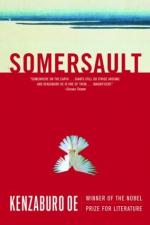|
This section contains 369 words (approx. 2 pages at 300 words per page) |

|
SOURCE: A review of Natsukashii toshi e no tegami, in World Literature Today, Vol. 62, No. 3, Summer, 1988, pp. 510-11.
[In the following review, Yoshida hails Natsukashii toshi e no tegami as a technically daring "milestone in Ōe's career."]
In the past Kenzaburō Ōe treated his concept of cosmos expansively in the novels Man'en gan'nen no futtobōru (1967; Eng. The Silent Cry, 1974) and Dojidai gemu (Contemporary Games; 1979). In the former, folkloric elements are quintessential to the formation of his cosmos; in the latter, mythical allusions are also utilized. In his new novel [Natsukashii toshi e no tegami, 1987] Ōe molds his microcosm on Dante's cosmology in The Divine Comedy, quoting from the work extensively.
The central theme of the novel is "the eternal dream time," an abstract structure in which the past, present, and future all overlap. The major organizing element in this time structure, however, is space, specifically the author's...
|
This section contains 369 words (approx. 2 pages at 300 words per page) |

|


